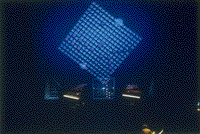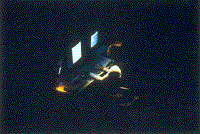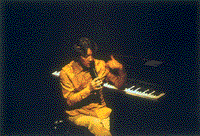 [1]
[1]





SAKAMOTO Ryuichi has been busy. In the last half of 1996 he went on a world tour with his piano trio and in early 1997 he completed a tour of Japan with his orchestra. Amid this flurry of activity he managed to find time for a collaboration with IWAI Toshio on December 16, 1996 at the Art Tower Mito. Despite its small scale, the collaboration was bursting with new possibilities--a truly fascinating experiment.
The basic mechanism was a MIDI piano linked to a video screen by IWAI and played by SAKAMOTO. The idea was based on IWAI Toshio's "Piano ~as image media" that I wrote about in Number 16 of InterCommunication. But let me give a brief explanation for those readers who may not be familiar with it. By connecting the piano to a computer via MIDI it is possible to send signals to the computer by striking the piano's keys and, conversely, to play the piano using signals sent from the computer. By using those signals to direct animated points of light in real time one can create the illusion of lights rising up from keys as they are struck, or keys sounding when the points of light fall on them from above. This performance at Mito was a very ambitious experiment, one where "music play(ed) images and images play(ed) music," in the most literal sense and the artists manipulated this simple device with a virtuoso's wizardry.
For example, in SAKAMOTO's solo performances pieces like "Bibo no Aozora (Beautiful Blue Sky)" and "Sheltering Sky", the deep resonance of the piano was beautifully embellished with white rainbows of light rising on the blue screen. In my review I wrote that the shapes and color schemes of the images in the original "Piano ~as image media" version were somewhat cheap. But this time around the problem was beautifully solved by keeping the shapes and colors to a minimum.
In a scene where SAKAMOTO and IWAI played a sort of expanded version of the "Otocky" game [1], each time they placed a dot on a grid on the screen, the corresponding piano key would sound, developing into a progressively noisier yet pleasant spectacle of sound and light. The combination of all the light and playful sense of a computer game with the heavy, tradition al grand piano made for an unprecedented effect. Between these extremes the relations between the sound and the images were diverse and yet always clear --creating a happy meeting of musical depth and visual levity. In that sense the goal expressed in the title was more than accomplished.
There were many other significant experiments as well. In one scene, for example, SAKAMOTO's gestures were captured with a video camera and converted into a swarm of dots on the screen, each of which caused a piano key to sound [2] [3]. This made it possible to create an enormous sound with great speed by the smallest movement of the body--an overwhelming dynamism that one could never manage with a mere ten fingers. In fact, feeling the sheer force of the MIDI piano in this scene one cannot help but wonder why pianists have spent so much time and effort mastering difficult pieces by the likes of Xenakis or Ligeti. In another scene [4] the keys were numbered from 1 to 88 and the Internet audience was invited to strike whatever keys they liked. The keys designated by SAKAMOTO sounded like a summer shower as he himself played a humorous and playful "accompaniment" by remote control to the piano playing at random. It may still be at a primitive stage, but this work did give a sense of the new kinds of performance made possible in the network age.
Of course not everything went perfectly. In a scene where key strokes from SAKAMOTO on one piano caused arches of light to strike corresponding keys on another to the right the computer couldn't handle the volume of sounds and went down in the middle of things (luckily only the end of the arches failed to appear and the performance itself was not interrupted). But this accident was nothing if not a sign of how passionately SAKAMOTO threw himself into this experiment. In any case, as the power of computers increases it will become much easier to execute complex performances. The problem is deciding what we want to make the computer do. SAKAMOTO Ryuichi and IWAI Toshio have consistently applied simple, lucid theory and come up with a persuasive answer to that question.
Many people in the past have attempted, like Scriabin with his Sound Organ, to find ways of adding the impact of light to music. Their dream is now being realized in the completely different form of an open and mutual relationship between music and images. SAKAMOTO Ryuichi and IWAI Toshio have shown us what we can expect in the twenty-first century. It was a unique performance which might just as easily have happened in New York or London. Those who got to see it in Mito were lucky indeed.
Enjoying Contemporary Music XIII: Ryuichi Sakamoto and Toshio Iwai, MUSIC PLAYS IMAGES X IMAGES PLAY MUSIC (Planning: Shin'ichiro Ikebe), December 16, 1996, Art Tower Mito.
ASADA Akira, social philosopher. Translation: J. Keith VINCEN.
All the photos appear by courtegy of ART TOWER MITO